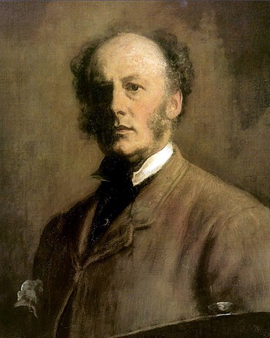The British painter and illustrator John Everett Millais (1829 - 1896) was born into a well-off middle-class family from Jersey. His mother was a lover of art and music and therefore promoted the young talent of her son. Millais later declared that he owed his mother everything. It was she who initiated the move from Jersey to London in 1838. There Millais, who was considered a child prodigy, attended Sass's Art School at the age of 9 and won his first silver medal from the Society of Arts. Only 2 years later he was accepted at the Royal Academy of Art. At the age of 11, he was the youngest student accepted by the Academy. There he also won various awards, for example a gold medal for his work "The Tribe of Benjamin Seizing the Daughters of Shiloh". During his time at the Royal Academy, the young Millais, who was called "The Kid" there, got to know William Holman Hunt and Dante Gabriel Charles Rossetti. With them he founded the Pre-Raphaelite Brotherhood in 1848. Millais was later recognized as the most talented of the three.
Millai's pre-Raphaelite works were highly controversial. Especially the painting "Christ in the House of His Parents" caused protests, because he depicted them as simple people of the working class. Among the critics was Charles Dickens, who accused Millai of blasphemy and lack of idealization. Millais found support in John Ruskin, one of the leading art critics of his time. He was a promoter of Millai's early style, which manifested itself in pictures like "Ophelia". Ruskin invited Millais to visit him in Scotland in 1853. There he met Ruskin's wife Effie. When she posed for his painting "The Order of Release", the two fell in love. Effie, who had been unhappily married for many years, separated from her husband. After their marriage was annulled, she married Millais in 1855 and the couple moved from London to Scotland to escape ridicule for their relationship, which was scandalous by then standards.
With the marriage Millai's style changed. He began to paint in a broader style, which Ruskin found disastrous. Millais had outgrown Pre-Raphaelism and was looking for new perspectives. Critics such as William Morris, however, accused him of selling out and being only interested in accumulating wealth. Thus his painting "A Child's World" was used for the advertising campaign of a well-known soap manufacturer. This did not harm Millais' reputation. He was the first artist to be awarded the title of Baron. Shortly before his death, he was also appointed President of the Royal Academy.
×





.jpg)
.jpg)
.jpg)
.jpg)
 - (MeisterDrucke-170445).jpg)
 - (MeisterDrucke-170445).jpg)
.jpg)
.jpg)
.jpg)
.jpg)
.jpg)
.jpg)
.jpg)
.jpg)
.jpg)
.jpg)
_-_(MeisterDrucke-323172).jpg)
_-_(MeisterDrucke-323172).jpg)
.jpg)
.jpg)
.jpg)
.jpg)
.jpg)
.jpg)
_-_(MeisterDrucke-982766).jpg)
_-_(MeisterDrucke-982766).jpg)
.jpg)
.jpg)
.jpg)
.jpg)
.jpg)
.jpg)
.jpg)
.jpg)
.jpg)
.jpg)
.jpg)
.jpg)
.jpg)
.jpg)
_-_(MeisterDrucke-1466531).jpg)
_-_(MeisterDrucke-1466531).jpg)
.jpg)
.jpg)
_-_(MeisterDrucke-548891).jpg)
_-_(MeisterDrucke-548891).jpg)
.jpg)
.jpg)
.jpg)
.jpg)
.jpg)
.jpg)
.jpg)
.jpg)
.jpg)
.jpg)
.jpg)
.jpg)
.jpg)
.jpg)
.jpg)
.jpg)
_-_(MeisterDrucke-1644220).jpg)
_-_(MeisterDrucke-1644220).jpg)
.jpg)
.jpg)
_ou_Marie_Iere_dEcosse_et_s_-_(MeisterDrucke-1644109).jpg)
_ou_Marie_Iere_dEcosse_et_s_-_(MeisterDrucke-1644109).jpg)
.jpg)
.jpg)
.jpg)
.jpg)
_-_(MeisterDrucke-905844).jpg)
_-_(MeisterDrucke-905844).jpg)
 - (MeisterDrucke-275490).jpg)
 - (MeisterDrucke-275490).jpg)
.jpg)
.jpg)
_-_(MeisterDrucke-1644322).jpg)
_-_(MeisterDrucke-1644322).jpg)
 - (MeisterDrucke-131792).jpg)
 - (MeisterDrucke-131792).jpg)
.jpg)
.jpg)
.jpg)
.jpg)
.jpg)
.jpg)
.jpg)
.jpg)
 - (MeisterDrucke-122725).jpg)
 - (MeisterDrucke-122725).jpg)
.jpg)
.jpg)
.jpg)
.jpg)
.jpg)
.jpg)
.jpg)
.jpg)
.jpg)
.jpg)
.jpg)
.jpg)
.jpg)
.jpg)
.jpg)
.jpg)
.jpg)
.jpg)
.jpg)
.jpg)
.jpg)
.jpg)
.jpg)
.jpg)
.jpg)
.jpg)
.jpg)
.jpg)
.jpg)
.jpg)
.jpg)
.jpg)
.jpg)
.jpg)
.jpg)
.jpg)
_-_(MeisterDrucke-695763).jpg)
_-_(MeisterDrucke-695763).jpg)
.jpg)
.jpg)
.jpg)
.jpg)
.jpg)
.jpg)
.jpg)
.jpg)
.jpg)
.jpg)
.jpg)
.jpg)
.jpg)
.jpg)
.jpg)
.jpg)
.jpg)
.jpg)
_pub_by_Henry_Gr_-_(MeisterDrucke-110739).jpg)
_pub_by_Henry_Gr_-_(MeisterDrucke-110739).jpg)
.jpg)
.jpg)
.jpg)
.jpg)
.jpg)
.jpg)
.jpg)
.jpg)
.jpg)
.jpg)
.jpg)
.jpg)
.jpg)
.jpg)
.jpg)
.jpg)
.jpg)
.jpg)
.jpg)
.jpg)
.jpg)
.jpg)
.jpg)
.jpg)
.jpg)
.jpg)
.jpg)
.jpg)
.jpg)
.jpg)
.jpg)
.jpg)
.jpg)
.jpg)
.jpg)
.jpg)
.jpg)
.jpg)
.jpg)
.jpg)
.jpg)
.jpg)
.jpg)
.jpg)
.jpg)
.jpg)
 - (MeisterDrucke-259082).jpg)
 - (MeisterDrucke-259082).jpg)






